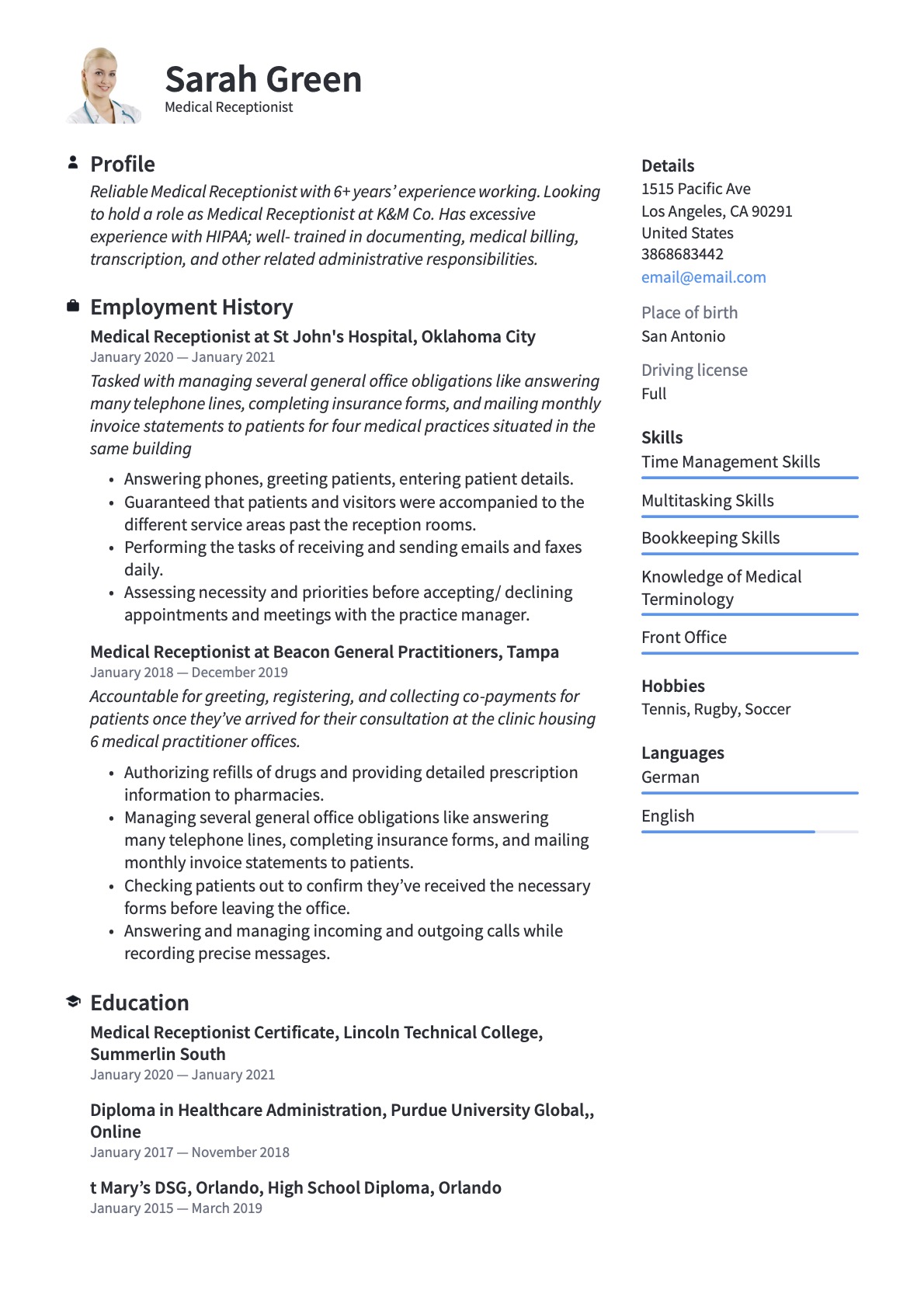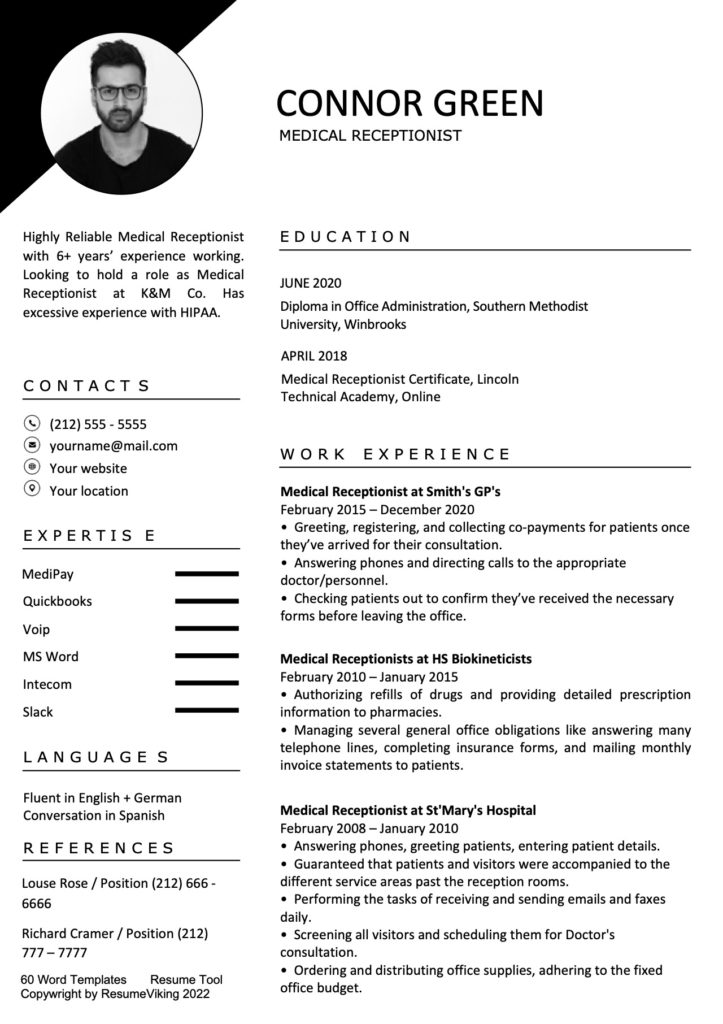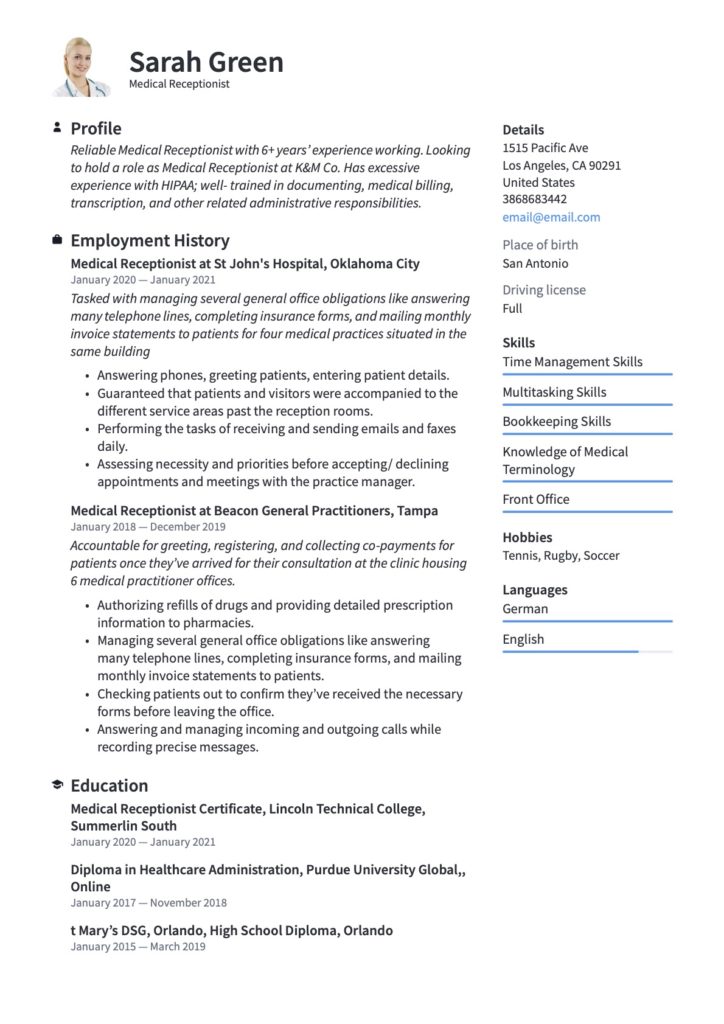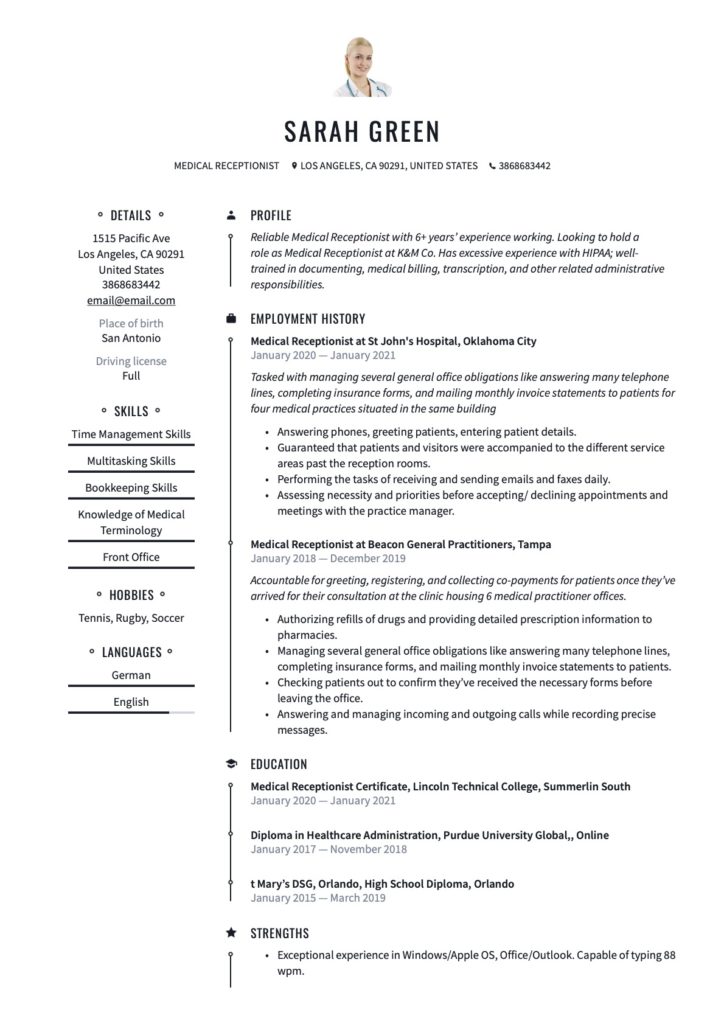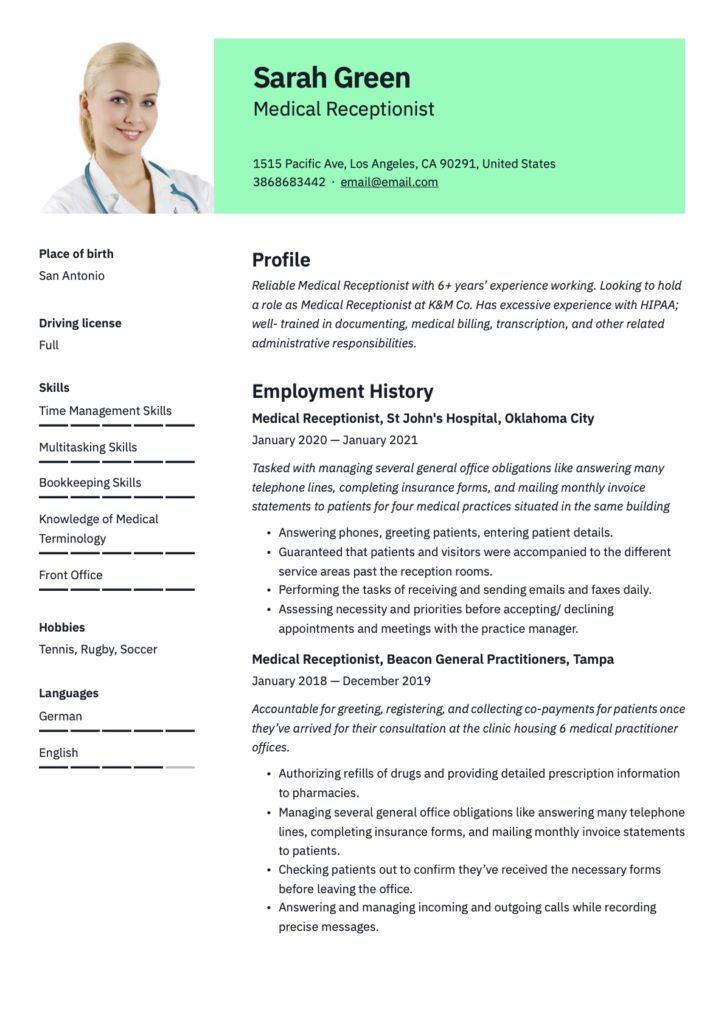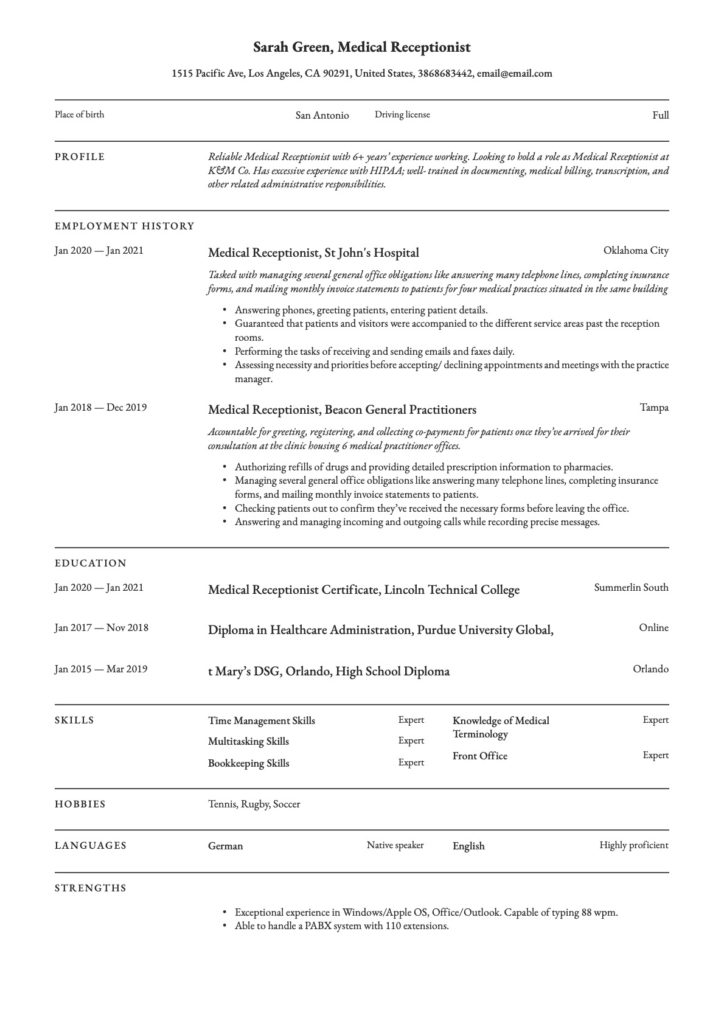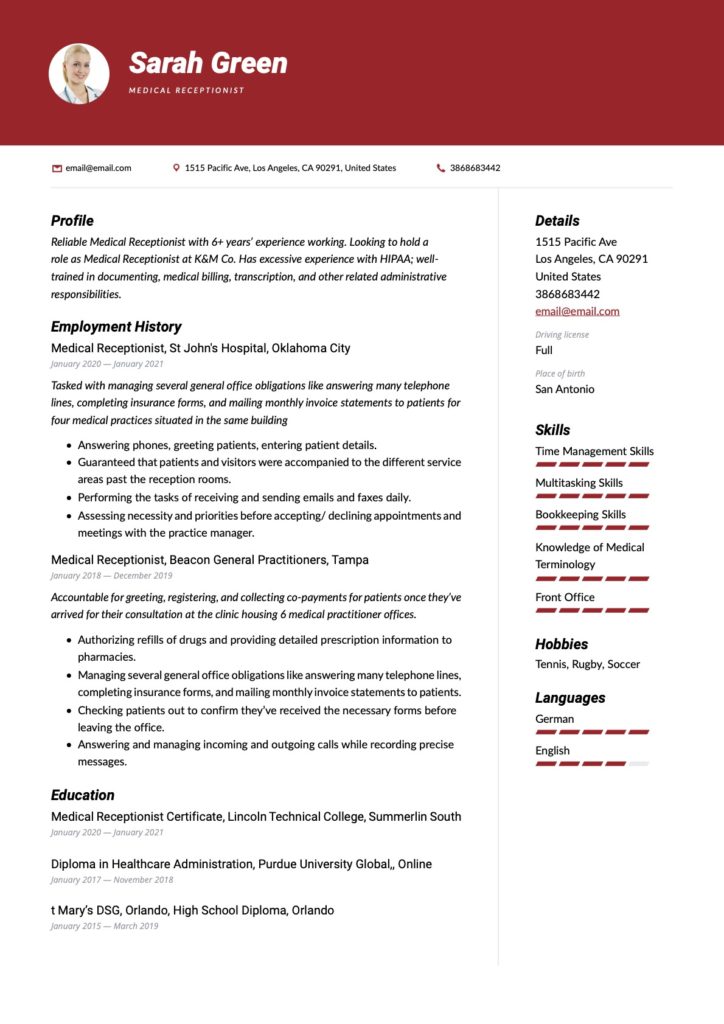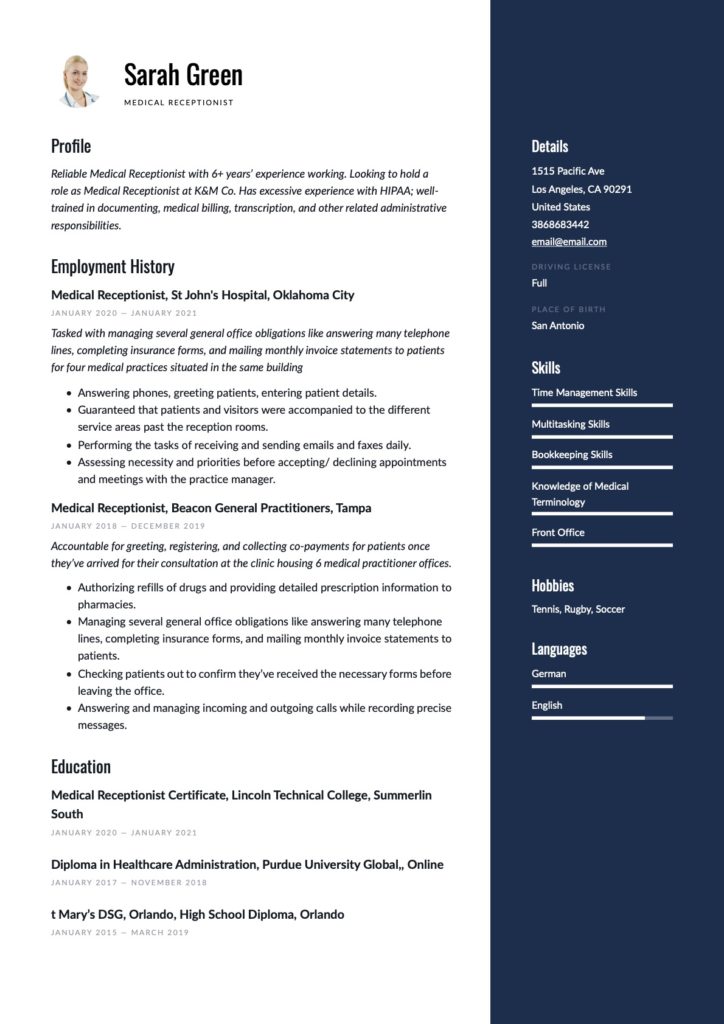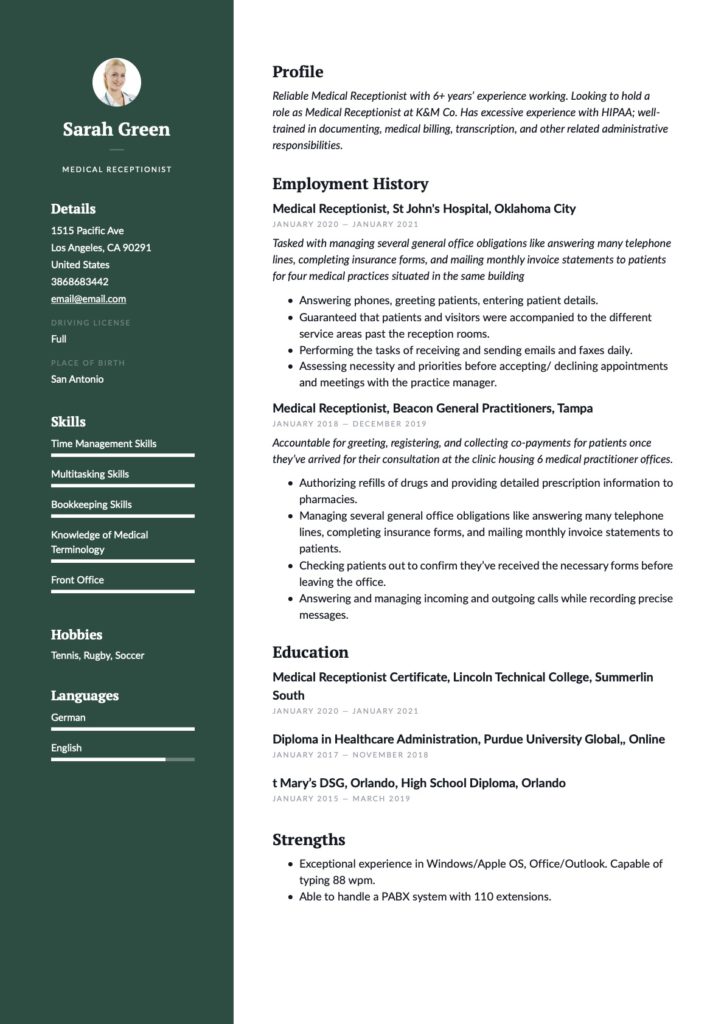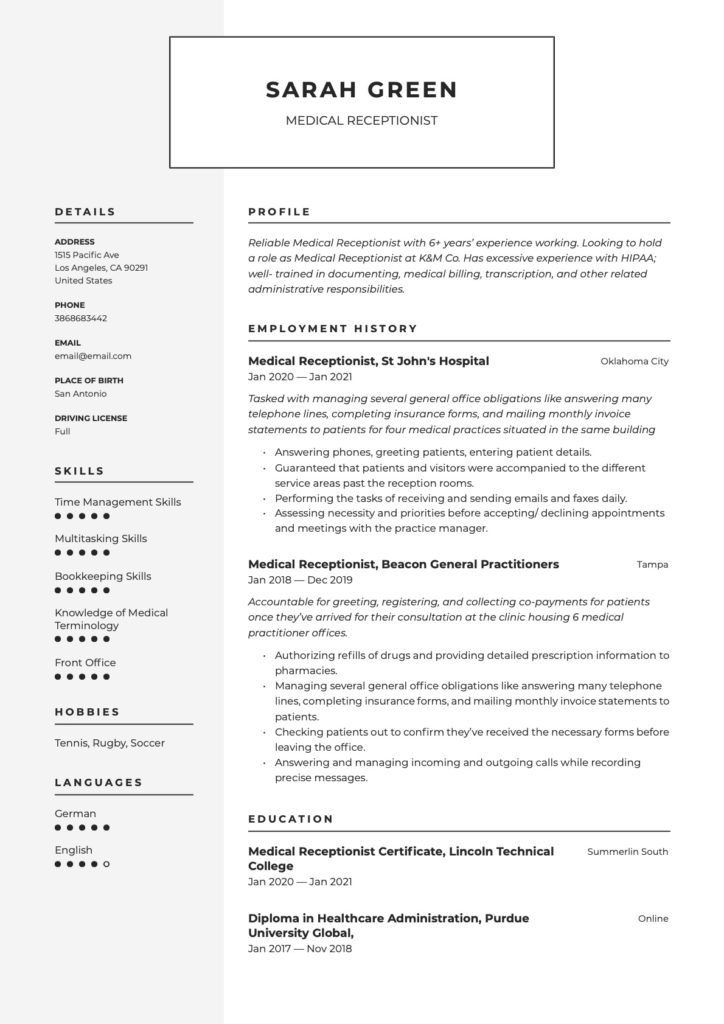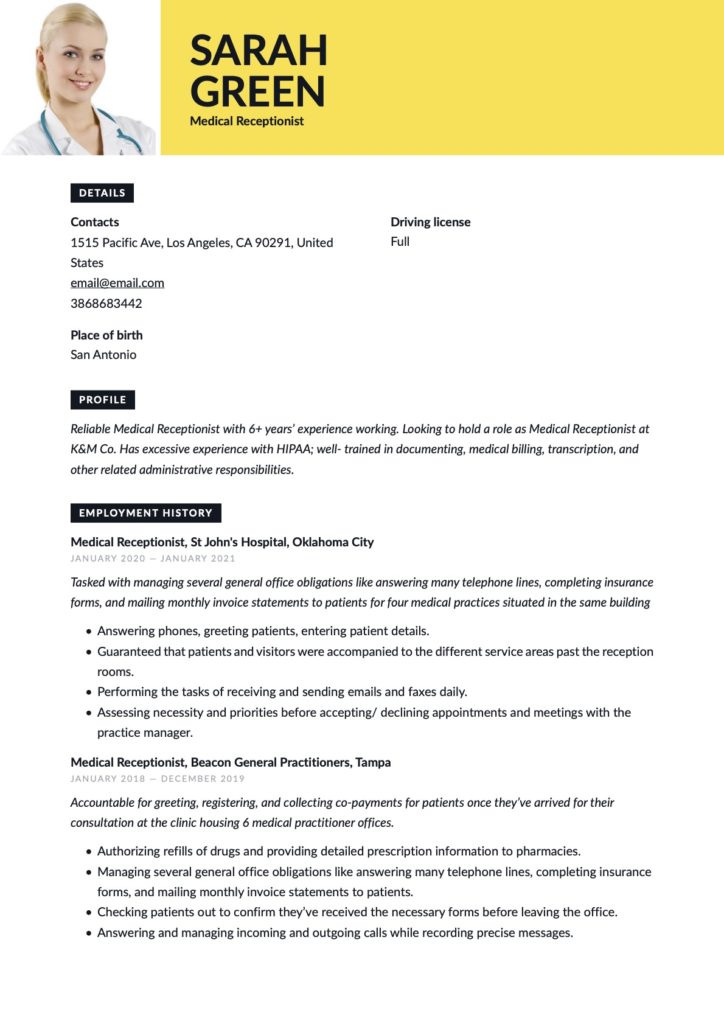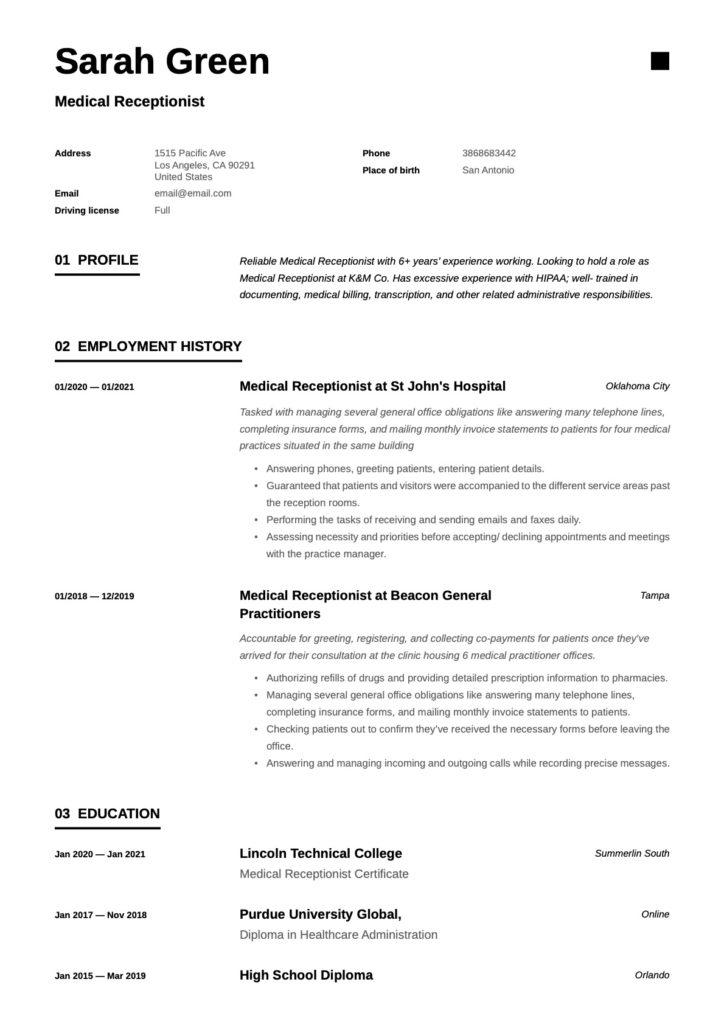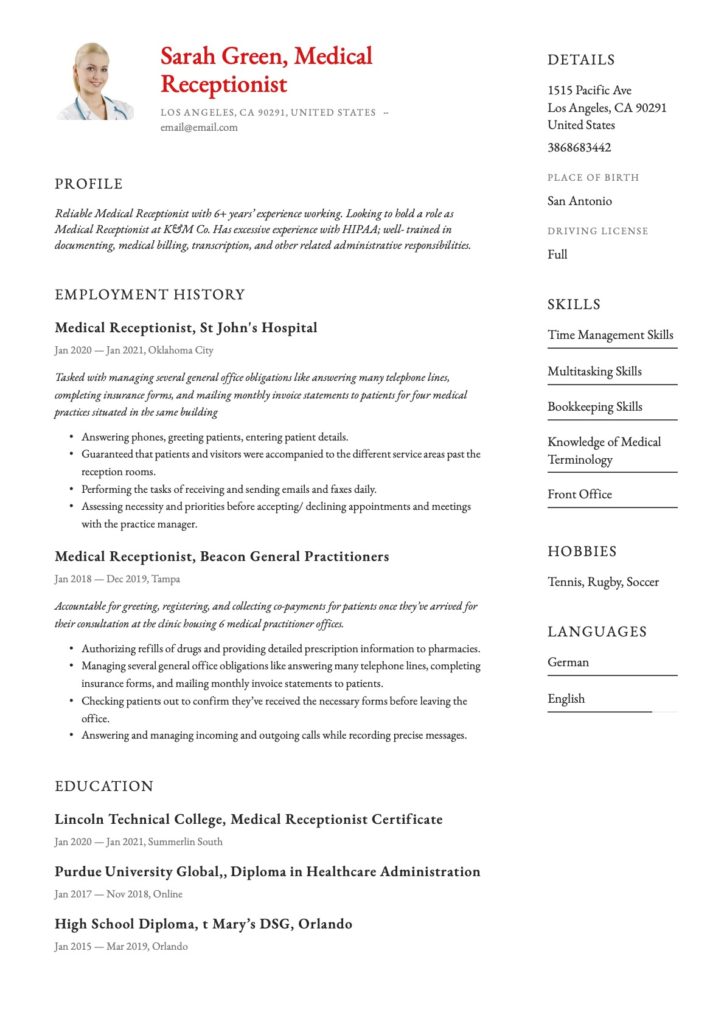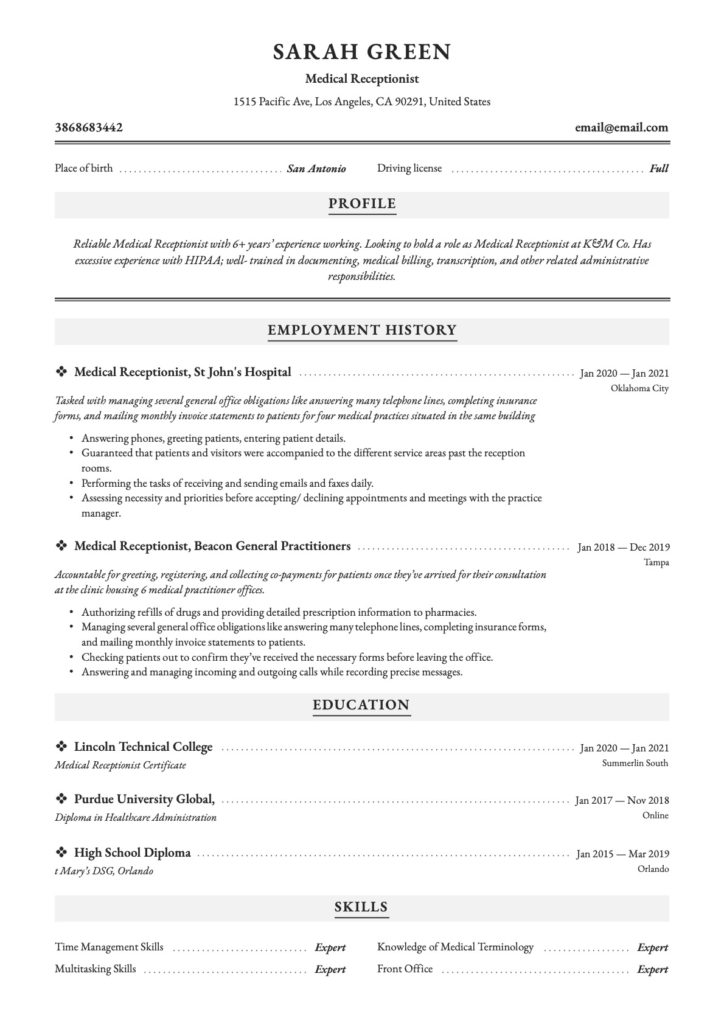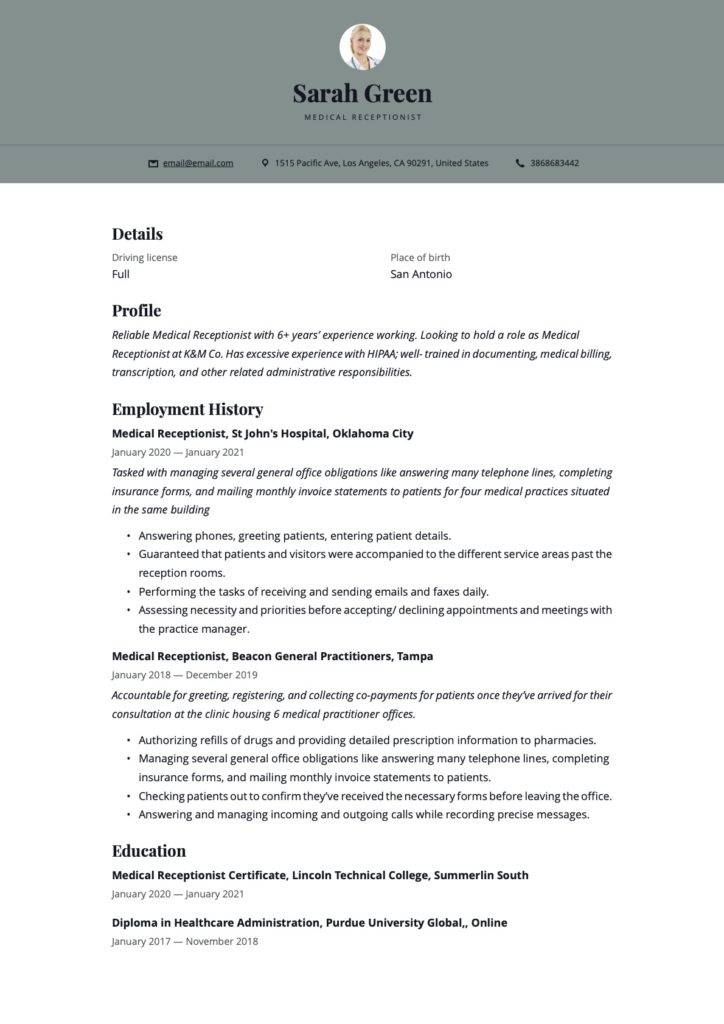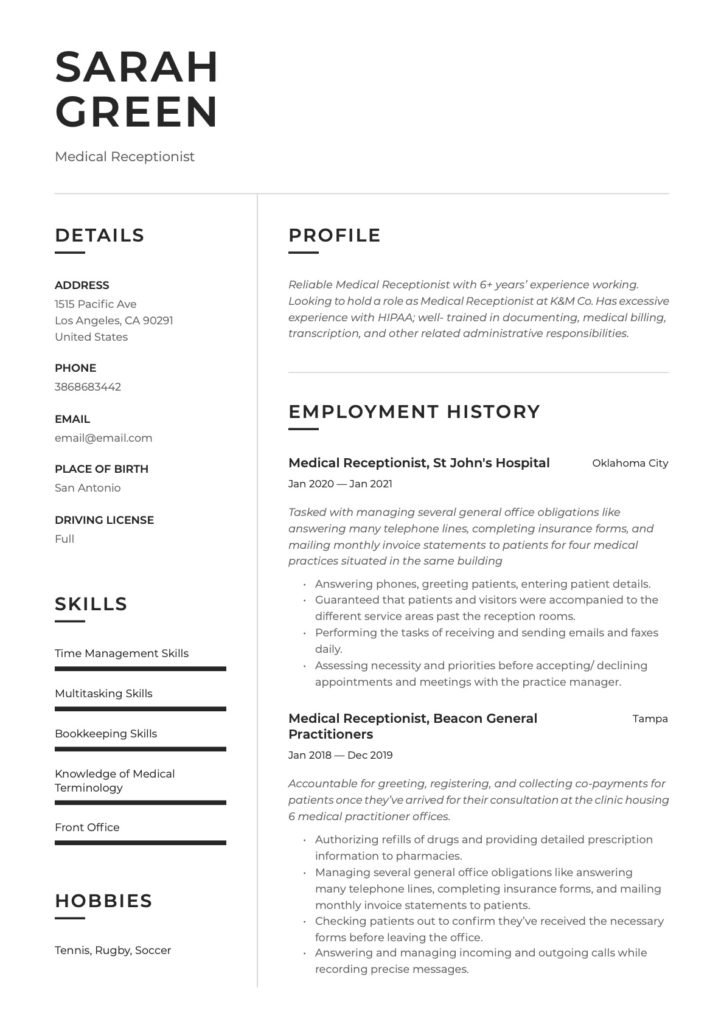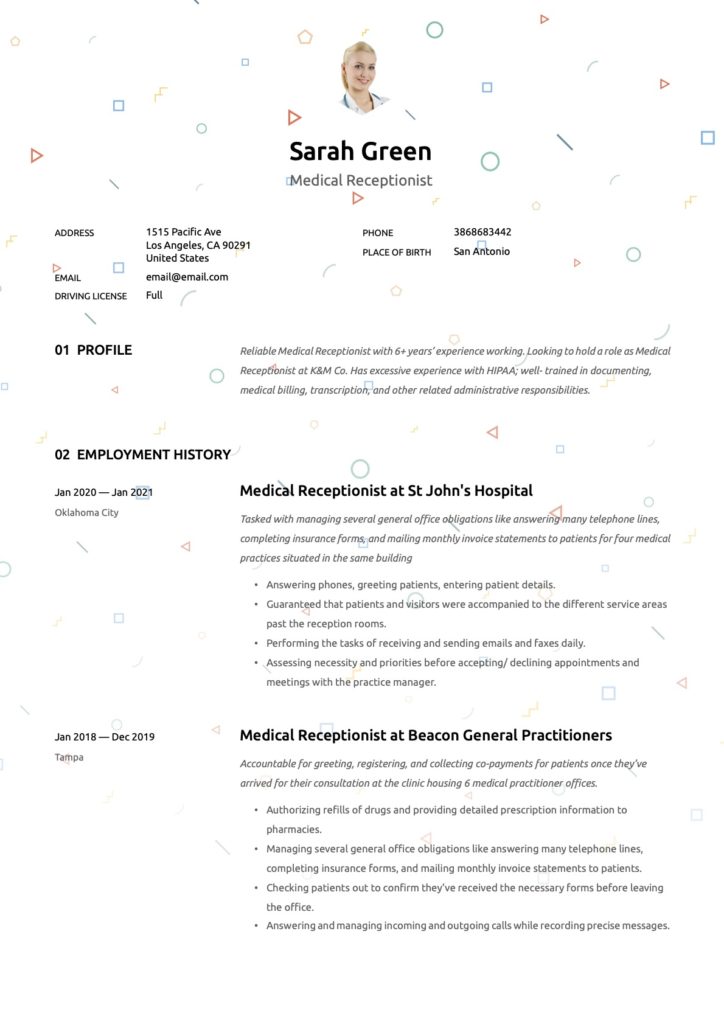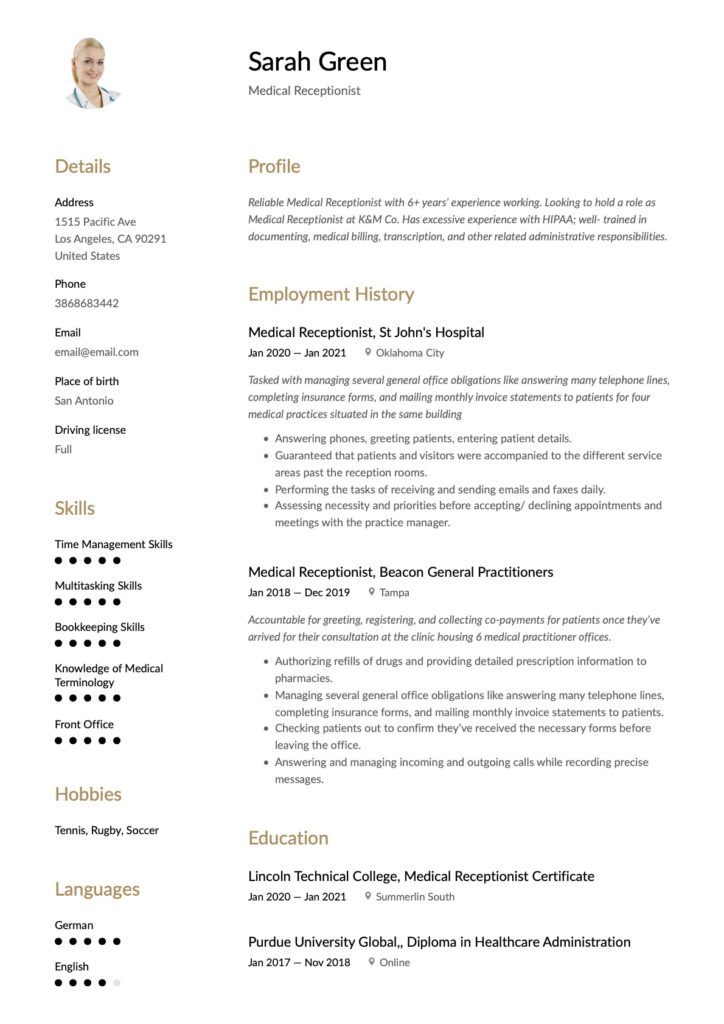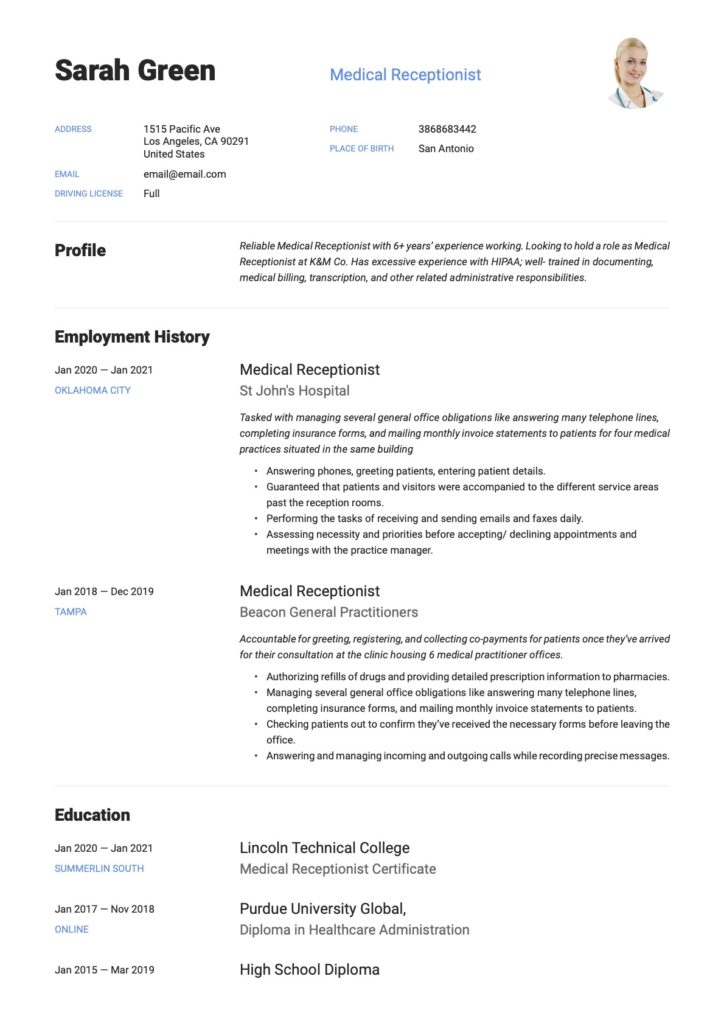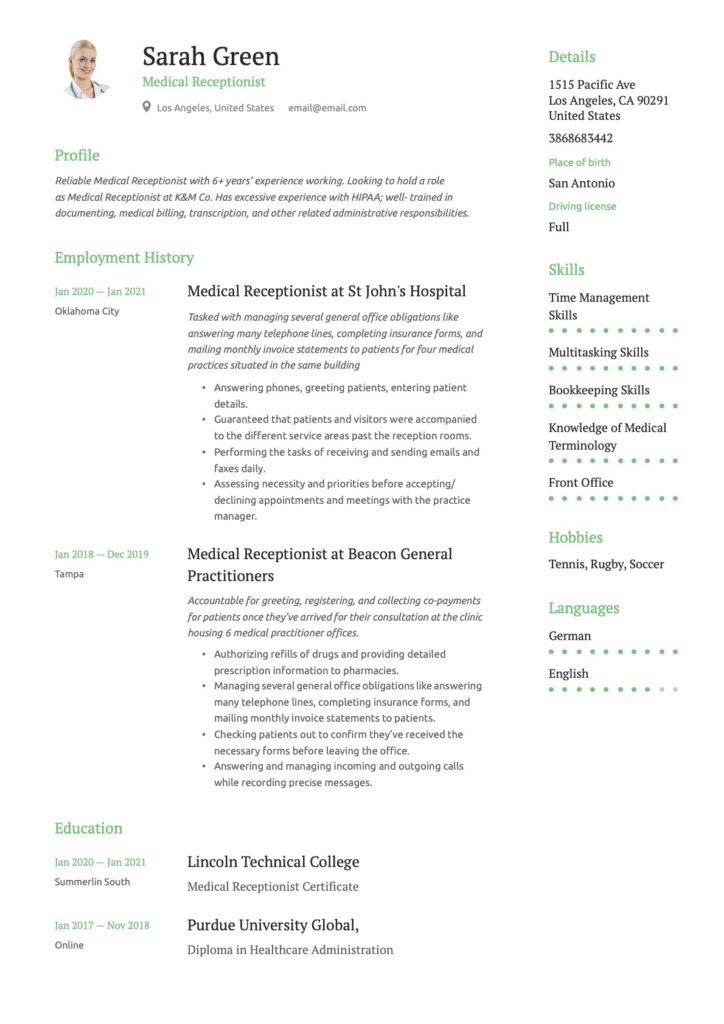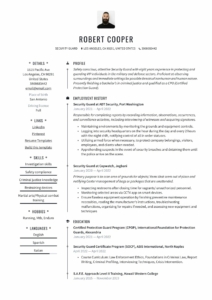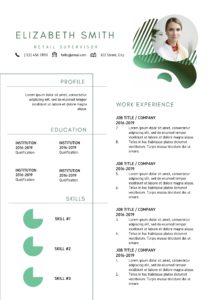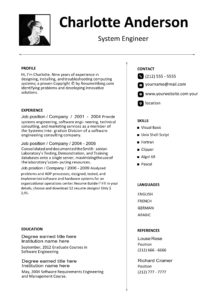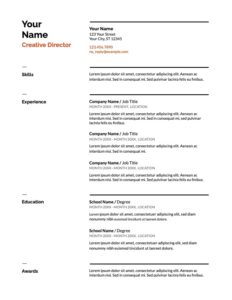Making a Medical Receptionist resume? We are here to help make your resume informative and gripping, without pestering recruiters with irrelevant info.
Our guide explains and covers each section of the resume, with specific examples for your medical receptionist resume. Get inspired and beef up that resume!
What you can read in this article
Medical Receptionist Resume Examples
(Free sample downloads are at the bottom of this page)
Medical Receptionist Resume Writing Guide
Resume Sections
1. Contact information
2. Profile Summary
3. Work History
4. Achievements
5. Education
6. Skill Section
7. Certification & Licensing
8. Extras: Languages/Awards/Publications/Volunteering/hobbies
What to Highlight in a Medical Receptionist Resume
Your work experience as a Medical Receptionist is important. Still, there are several other things recruiters and managers must know about you to confirm you’re the right fit for the team:
Highlight your scope as a receptionist. There are tons of medical practices all over with every conceivable area of specialization offered to patients. You must be specific here, stating which industry you worked in. This includes whether you’ve dealt with walk-in patients, the average number of calls you made daily, and the PABX switchboard size.
A Medical Receptionist is normally the ‘’face of the business’’. Sitting at the practice, clinic, or hospital's front desk, you must show recruiters you’re proficient in giving outstanding customer service, deal with various client requests simultaneously, and professionally handle complaints.
Recruiters value a candidate’s resume experience that is focused on experience with direct patient contact. Definitely showcase this clearly in your resume:
- Smaller clinics value Receptionists who are capable of wearing multiple hats vs. larger facilities who value specificity.
- Domain-specific experience is highly valued.
- Proven soft skills and patient handling is valued immensely.
Medical Receptionists are involved in administrative support obligations like distributing messaging, scheduling appointments and sending emails regarding patients' information. The responsibilities include answering queries and handing out information to the public, visitors, customers, and other interested parties about the establishment's services.
Make sure you know the layout of your work well, as you will often be asked to play the role of Human Google Maps, giving directions all over the establishment.
This section is where you list the applications and systems you can work with, such as Calendly, Outlook, Zoom, Acuity, Webex, Clarity, VoIP, and Agile CRM (these are just examples).
Lastly, there are the targets, goals, and KPI metrics you’ll have to get. Make sure you’re specific with your numbers here, for example, how many incoming daily customers, how many were regulars and new customers, the average number of daily calls taken, or the number of switchboard extensions you are in charge of.
*Cool Tip for an awesome resume
By breaking up your job description into the core duties of a Medical Receptionist, you really can make a good impression:
- Customer Service:
Creating a welcoming environment and providing brilliant customer service. Meeting and greeting patients that enter the building. Escorting patients to where they need to be. - Queries:
Answering patients' questions regarding appointments, prices, the product uses, availability, and payment terms if their account with the practice is active. - Administration:
Filing and maintaining records and updating the practice’s database. Receiving payments and filing receipts. Proofreading documents and transcribing written meeting minutes. Photocopy and scan as needed. - Switchboard:
Answering, screening, and forwarding calls. Providing information and taking messages. - Diary Management:
Scheduling appointments and booking room consultation. Maintaining and updating calendars. Manages travel arrangements.
Summaries & Objectives
Recruiters have to go through many resumes with very little time in their day to do it. You must keep your career summary/ career objective sharp and to the point. Put the most important and relevant info first to grab their attention while they scan your resume. They want to see instantly that you’re cut out for the job.
The career summary begins with the years of experience you have in the industry and the main responsibilities you had. Utilize the job ad as your guide when you decide which tasks to include. The more keywords from the ad you use, the better you will seem to fit in the recruiter's eyes.
Next up, include a line that highlights all your exceptional qualities that can add value to the company. Recruiters will be interested in knowing if you possess “strong people skills, brilliant multitasking capabilities, creative engagement skills and that you are a guru with handling difficult customers.” Ensure you can provide proof of these skills in the “professional experience” section of your resume.
The career objective would be applicable if you have less than 5 years of experience or have recently graduated. In a career objective, you want to show your career aspirations, in other words, indicating that you prioritize actualization and want to grow in your career. But, you should also include your intent to add value. This means selecting 2 or 3 personality traits and skills that you have mastered, which would add value to the potential employer.
Examples
Summary Example 1
"Reliable Medical Receptionist with 6+ years’ experience working. Looking to hold a role as Medical Receptionist at K&M Co. Has excessive experience with HIPAA; well- trained in documenting, medical billing, transcription, and other related administrative responsibilities."
Summary Example 2
"Highly efficient Medical Receptionist with 4+ years’ experience in a high-paced multi-physician practice. Amiable and well-mannered in all interactions with patients and team members. In DEF Hospital, employed a new CRM platform for managing oncology patients, cutting costs by 15% while improving accuracy. Seeking a position at EFG Hospital to aid minimalization in errors and improve processes while continually working to improve patient satisfaction scores."
And now, Career Objective. Beginning your resume with an attractive Career Objective will improve its chances of being read, thereby improving your chances of scoring an interview.
Resume Objective Examples
Summary Example 1
"Seeking a medical receptionist role with (Insert Company Name); Possess exceptional written and oral communication, computer, and organization skills to help the hospital achieve its goals."
Summary Example 2
"Lively and dependable Medical Receptionist, seeking a position with (Insert Company Name). Bringing to the table brilliant front desk handling skills, deep knowledge of medical terminology, and the capabilities to work in stressful situations, maximizing the reception area's efficiency."
Employment History
Obviously, your experience as a Medical Receptionist should be the first thing written under this section, unless you include a professional summary. Your experience as a medical assistant is the first thing recruiters are going to want to know about. In this section, showing is more important than telling. Use bullets but keep it concise. In every bullet, you put down, include the impact you had in that position and follow it up with a solid example.
The typical length of resumes today is 1-2 pages, meaning you have to be stingy with space in your resume. Only list other employment experiences if you’re an entry/ junior level Creative Directive to beef up your resume. If you’re making a career change, then you must also put in prior work experiences here.
Next, you must choose what to include and in which format to write it. The best-accepted format is reverse chronological order, starting with your most recent/ current job, then listing all the rest. You can’t bombard the recruiter with everything you have done, so you need to mold your resume and chose what the recruiter wants to see.
Below is a list of the basic (proven) responsibilities a recruiter would expect to see in the resume:
Samples
Medical Receptionist at St John’s Hospital, New York
January 2015 – December 2018
Tasked with managing several general office obligations like answering many telephone lines, completing insurance forms, and mailing monthly invoice statements to patients for four medical practices situated in the same building
- Answering phones, greeting patients, entering patient details.
- Guaranteed that patients and visitors were accompanied to the different service areas past the reception rooms.
- Performing the tasks of receiving and sending emails and faxes daily.
- Assessing necessity and priorities before accepting/ declining appointments and meetings with the practice manager.
Medical Receptionist at Smith & Beacon GP’s, Nashville
January 2009 – December 2016
Accountable for greeting, registering, and collecting co-payments for patients once they’ve arrived for their consultation at the clinic housing 6 medical practitioner offices.
- Authorizing refills of drugs and providing detailed prescription information to pharmacies.
- Managing several general office obligations like answering many telephone lines, completing insurance forms, and mailing monthly invoice statements to patients.
- Checking patients out to confirm they’ve received the necessary forms before leaving the office.
- Answering and managing incoming and outgoing calls while recording precise messages.
Job Descriptions Examples
Further Job Duty Samples for Medical Receptionists
A Junior Medical Receptionist may:
- Greeting, registering, and collecting co-payments for patients once they’ve arrived for their consultation.
- Answering phones and directing calls to the appropriate doctor/personnel.
- Checking patients out to confirm they’ve received the necessary forms before leaving the office.
A Senior Medical Receptionist may:
- Creating detailed expense reports and requesting capital expenditures.
- Assessing necessity and priorities before accepting/ declining appointments and meetings with the CEO.
- Screening all visitors and scheduling them for Doctor's consultation.
- Ordering and distributing office supplies, adhering to the fixed office budget.
- Directing guests and routing deliveries/ courier services.
- Answering and managing incoming and outgoing calls while recording precise messages.
Accomplishments
You might want to copy and paste the duties you did in previous jobs in your experience section, but please don’t do this! Yes, it’s quicker and easier, but you won’t stand out from the crowd, and separating yourself from all the other applicants is really what you want. Think about what makes you unique and what you’re most proud of having accomplished in your prior roles and include these using punchy statements.
Examples
Flat, Simple Duty (Boring, don’t do this!):
- Administrative obligations include copying, typing, handling the switchboard, emailing, faxing, and scheduling.
Accomplishment Statement (Sounds way better!):
- Exceptional experience in Windows/Apple OS, Office/Outlook. Capable of typing 88 wpm. Able to handle a PABX system with 110 extensions.
Quantifying Your Resume
Guys, quantifying is crucial! It’s all good and well just stating something, but you need to be able to give the recruiters solid facts with numerical values to back up what you’re stating. In other words, prove it. You should be answering the “how much?” or “how many?” questions. For instance:
- How many calls are you taking daily?
- How many incoming patients are you helping at the front desk?
- What is your success in retrieving collections of accounts not paid?
Examples
- Handled 120 patients' call-ins a day and serviced an average of 25 walk-in emergencies during weekdays.
- Proofread and typed up to 15 medical insurance contracts daily, averaging a typing speed of 105 words per minute.
- Process up to 150 new patient files per week with a zero error ration held for the last 12 months.
Education
This section is essential, even if you don’t have a degree. Many Medical Receptionists either have an associate degree or they merely joined a certification program.
Recruiters typically look for the university/ school name, the type of degree/ certificate achieved, and graduation date. The other details aren’t really all that important.
If you haven’t got all that much work experience or freshly graduated, consider adding your GPA IF you did exceptionally well.
If you have several things to add to your education section, you must first put the most recent/ relevant one. Normally these are the same thing, but there are exceptions. Please don’t go too fancy here; keep it concise and easy to read.
Completed Secondary and Tertiary Education must be listed as follows:
Firstly, start with the beginning and end dates of your degree/ certificate/ diploma, etc. If you only did a course, then just the end date. Next, put the full name of the qualification down, then the name of the institution you studied at, followed by the city or abbreviated state name. If you have less than five years’ working experience, include your high school diploma in the same format as stated above.
Examples
2019 – 2020 Medical Receptionist Certificate, Lincoln Technical College, IN
2016-2018 Diploma in Healthcare Administration, Purdue University Global, MI
2015 – High School Diploma, St Mary’s DSG, Orlando, FL
Resume Skills
This section is really what interests the recruiters. It shows how you will add value to the business and will differentiate you from the other applicants. This is where you will need to be clever with your word use to make recruiters want to meet you.
This section is a small taste of what you’ll present in the interview.
For this reason, you must use this section wisely by mastering the aspects and such as placement and content. This is why it is necessary to use it wisely and master the aspects, especially in placement and content. Because the “skills” section is related to your educational background and professional experience, make sure to put this section closely to the other two.
Just make sure you aren’t redundant by repeating what was said in the “educational” and “professional experience” sections in your “skills” section.
The medical reception field does need certain technical skills, but recruiters also look at your soft skills. These are personality traits and skills that demonstrate how to fit you are as a Medical Receptionist in adding value by achieving set targets, has sufficient knowledge, and ample experience with answering customer queries or directing them to the suitable person to contact. Integrate these with your summary/ profile, and into your accomplishment statements.
Don’t ramble. Give the recruiter concise information and make them want to meet you.
Basically, design a significant level of resume SEO to beat the ATS systems, meaning your application will land in the hands of a human recruiter. Using the exact terms and keywords used in the job ad and incorporating them into your resume is a good way to do this (in all your sections, not just this one).
The technical skills or ‘hard' skills relate to the skills gained in repetitive tasks during the course of your work. For example, accurate calculation methods, data entry, management of a software suite, etc.
Examples of Technical Skills for a Medical Receptionist:
- Front Desk
- Front Office
- Billing
- Data Entry
- Microsoft Office
Non-technical skills or ‘soft' skills related to the human skills attained during your professional experience. They are developed from personal points of view. Keep in mind that even with similar professional experience, not everyone will develop the same non-technical skills, such as managing a team, empathy, conflict resolution, rapport with young children, etc.
Examples of Soft Skills for a Medical Receptionist:
- Multitasking
- Customer Service
- Organization
- Time Management
- Meticulous
Qualifications & Certifications associated with Medical Receptionists
| Diploma in Office Administration | High school Diploma | Principles of Customer Service Certificate |
| Executive Office Assistant Course | GED | Advanced Office Management Course |
| Front Desk and Telephone Skills Workshop | Short Course in Conflict Resolution | Front Desk Professional Image Building Certificate |
Optional Extras for Medical Receptionist Resumes
This job involves much dealing with people and patients. It will be to your advantage to use this section to provide recruiters with proof, using your hobbies and passions. Show them that you are a joy to be around and your people skills are top tier.
This will also help set your resume apart from the rest of the applicants as it will make you sound like a genuine person and not a robot.
Consider this a personal “Most Proud Of” section. Sharing a story about triumphing over hardship, I life-lesson you learned, or simply something that meant a lot to you will make your resume stand out.
Points you can highlight:
- Hobbies
- Interests
- Sports
- Cultural
- Additional Languages
- Volunteering
Professional Information for Medical Receptionists
Sectors: Medical, Clinical, Healthcare, Wellness
Career Type: Administration, Customer Service, Client Relations, Front Office
Person type: Communicator, Engager, Supporter, Organizer
Education levels: High School Diploma to Post School Diplomas
Salary indication: $14.34 per hour (Indeed)
Labor market: 4% Growth between 2019 – 2029 (Study.com)
Organizations: Hospitals, Medical Facilities, Clinics, Wellness Centres, Physician Practices
